Comprehensive Report: Electromagnetic Spectrum, Properties & Effects
VerifiedAdded on 2023/06/18
|9
|2321
|485
Report
AI Summary
This report provides a detailed analysis of the electromagnetic spectrum, beginning with the principles and properties of electromagnetic waves, including their ability to travel through a vacuum, transverse nature, and interference/diffraction characteristics. It compares and contrasts visible and ultraviolet light, highlighting differences in energy, visibility, and applications, such as UV light's use in medical and industrial processes versus visible light's use in displays and communication. The report also examines the properties of microwaves and infrared radiation, including their frequencies, wavelengths, and applications in cooking and heat production, respectively. Furthermore, it discusses the effects of ultraviolet and infrared radiation on human health, noting the risks of skin aging, corneal damage, and retinal burns. Finally, the report addresses the uses and hazards of X-rays, emphasizing their diagnostic importance in medicine while cautioning against the risks of high exposure, such as increased cancer risk and other adverse health effects. The document concludes by citing relevant research to support its claims.
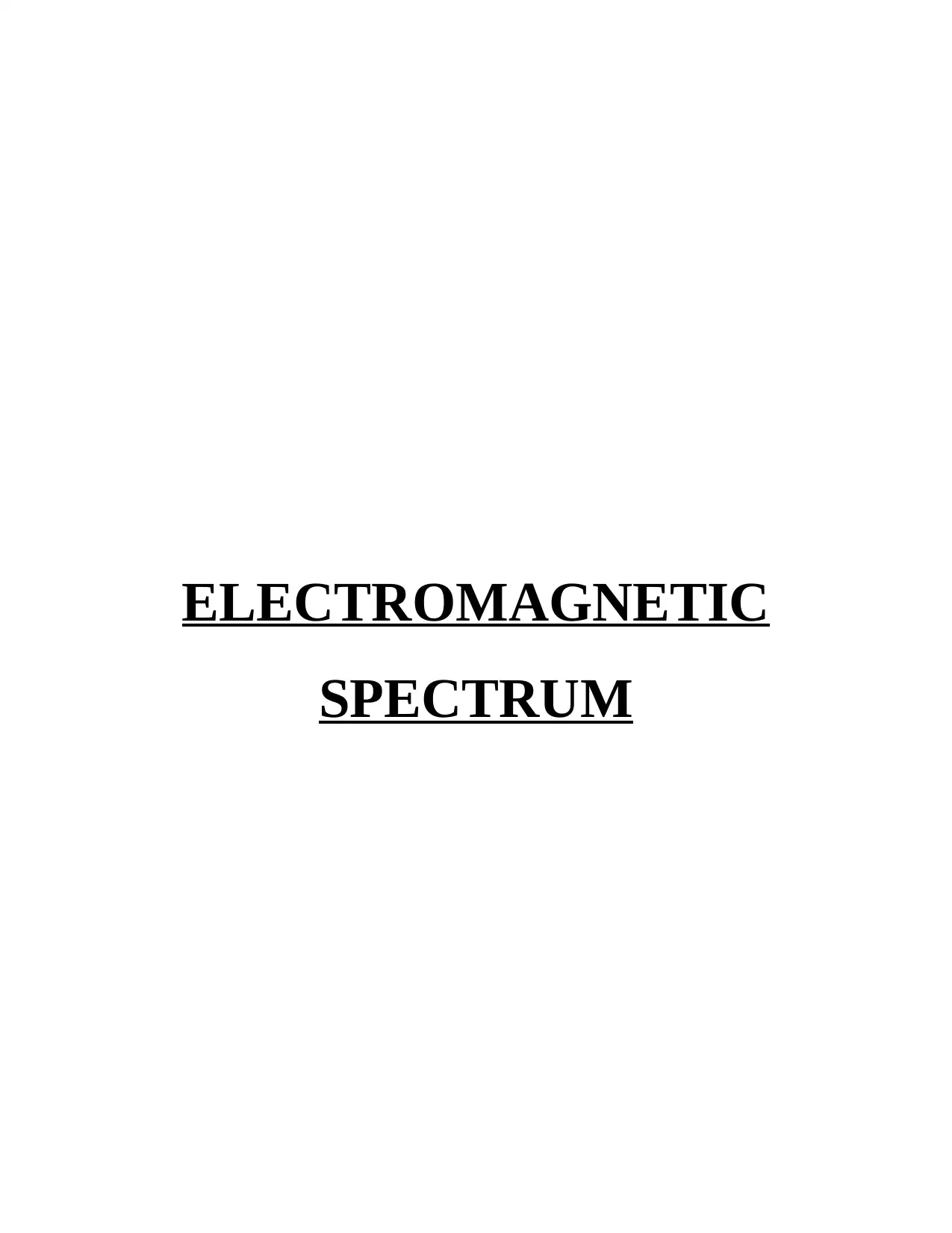
ELECTROMAGNETIC
SPECTRUM
SPECTRUM
Paraphrase This Document
Need a fresh take? Get an instant paraphrase of this document with our AI Paraphraser
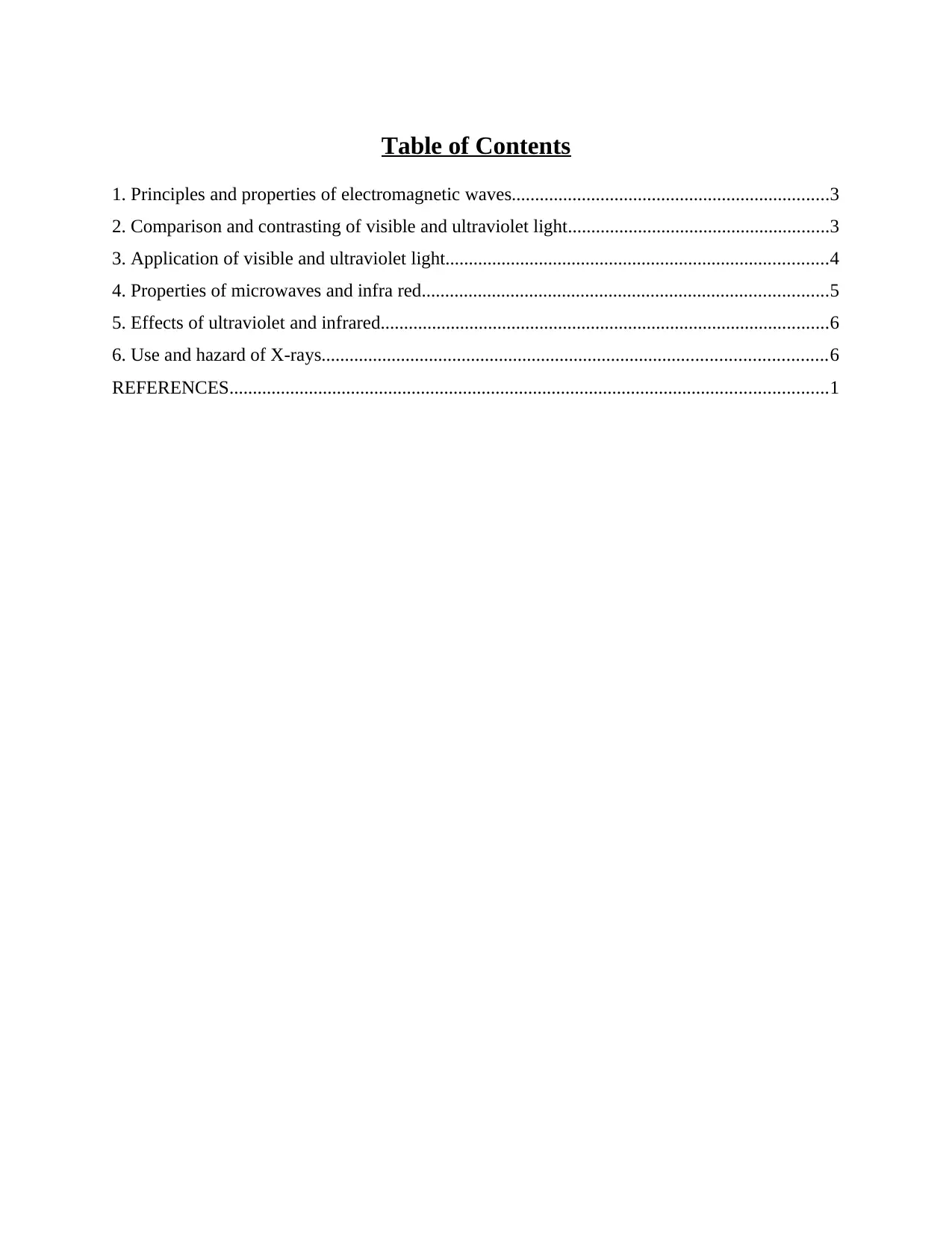
Table of Contents
1. Principles and properties of electromagnetic waves....................................................................3
2. Comparison and contrasting of visible and ultraviolet light........................................................3
3. Application of visible and ultraviolet light..................................................................................4
4. Properties of microwaves and infra red.......................................................................................5
5. Effects of ultraviolet and infrared................................................................................................6
6. Use and hazard of X-rays............................................................................................................6
REFERENCES................................................................................................................................1
1. Principles and properties of electromagnetic waves....................................................................3
2. Comparison and contrasting of visible and ultraviolet light........................................................3
3. Application of visible and ultraviolet light..................................................................................4
4. Properties of microwaves and infra red.......................................................................................5
5. Effects of ultraviolet and infrared................................................................................................6
6. Use and hazard of X-rays............................................................................................................6
REFERENCES................................................................................................................................1
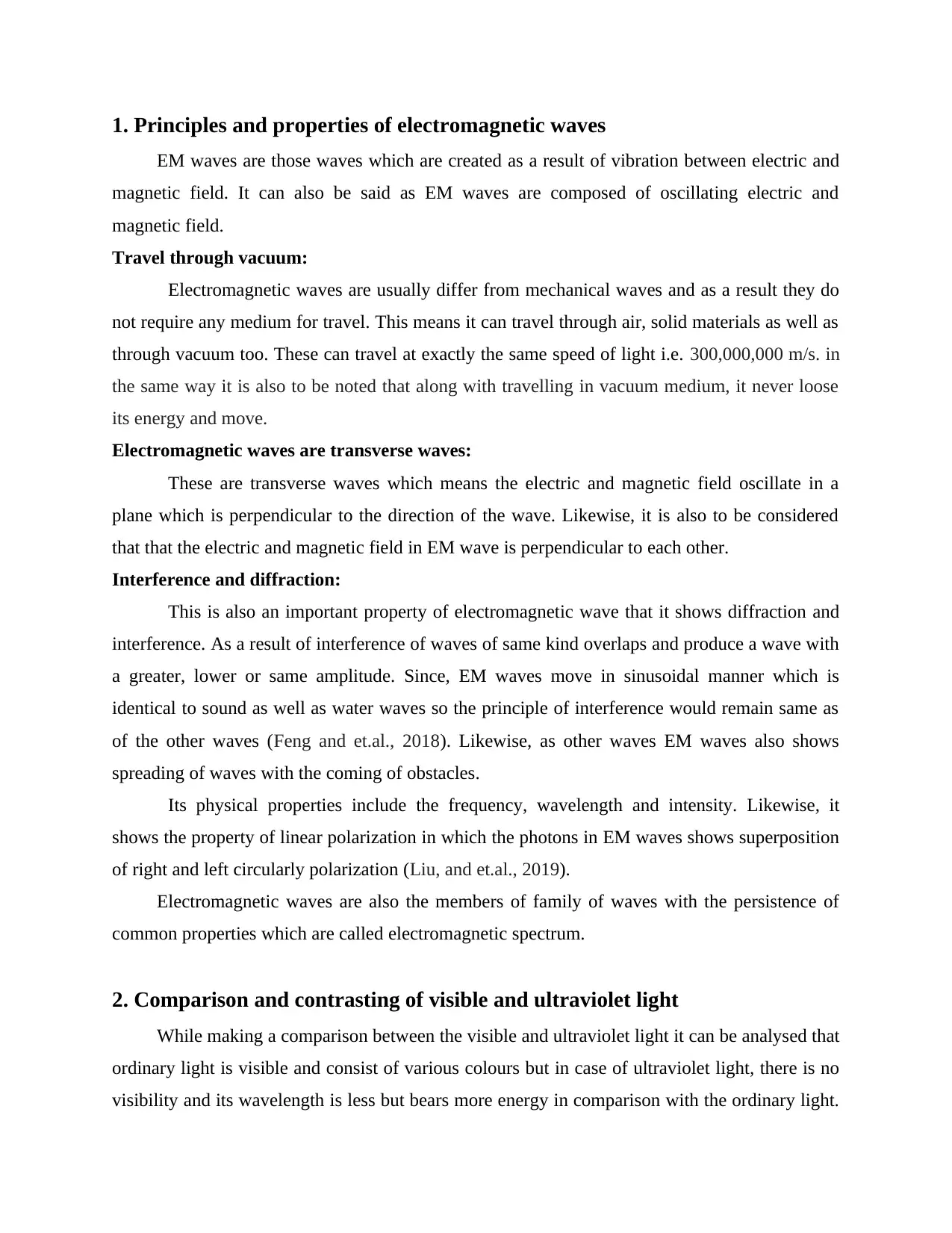
1. Principles and properties of electromagnetic waves
EM waves are those waves which are created as a result of vibration between electric and
magnetic field. It can also be said as EM waves are composed of oscillating electric and
magnetic field.
Travel through vacuum:
Electromagnetic waves are usually differ from mechanical waves and as a result they do
not require any medium for travel. This means it can travel through air, solid materials as well as
through vacuum too. These can travel at exactly the same speed of light i.e. 300,000,000 m/s. in
the same way it is also to be noted that along with travelling in vacuum medium, it never loose
its energy and move.
Electromagnetic waves are transverse waves:
These are transverse waves which means the electric and magnetic field oscillate in a
plane which is perpendicular to the direction of the wave. Likewise, it is also to be considered
that that the electric and magnetic field in EM wave is perpendicular to each other.
Interference and diffraction:
This is also an important property of electromagnetic wave that it shows diffraction and
interference. As a result of interference of waves of same kind overlaps and produce a wave with
a greater, lower or same amplitude. Since, EM waves move in sinusoidal manner which is
identical to sound as well as water waves so the principle of interference would remain same as
of the other waves (Feng and et.al., 2018). Likewise, as other waves EM waves also shows
spreading of waves with the coming of obstacles.
Its physical properties include the frequency, wavelength and intensity. Likewise, it
shows the property of linear polarization in which the photons in EM waves shows superposition
of right and left circularly polarization (Liu, and et.al., 2019).
Electromagnetic waves are also the members of family of waves with the persistence of
common properties which are called electromagnetic spectrum.
2. Comparison and contrasting of visible and ultraviolet light
While making a comparison between the visible and ultraviolet light it can be analysed that
ordinary light is visible and consist of various colours but in case of ultraviolet light, there is no
visibility and its wavelength is less but bears more energy in comparison with the ordinary light.
EM waves are those waves which are created as a result of vibration between electric and
magnetic field. It can also be said as EM waves are composed of oscillating electric and
magnetic field.
Travel through vacuum:
Electromagnetic waves are usually differ from mechanical waves and as a result they do
not require any medium for travel. This means it can travel through air, solid materials as well as
through vacuum too. These can travel at exactly the same speed of light i.e. 300,000,000 m/s. in
the same way it is also to be noted that along with travelling in vacuum medium, it never loose
its energy and move.
Electromagnetic waves are transverse waves:
These are transverse waves which means the electric and magnetic field oscillate in a
plane which is perpendicular to the direction of the wave. Likewise, it is also to be considered
that that the electric and magnetic field in EM wave is perpendicular to each other.
Interference and diffraction:
This is also an important property of electromagnetic wave that it shows diffraction and
interference. As a result of interference of waves of same kind overlaps and produce a wave with
a greater, lower or same amplitude. Since, EM waves move in sinusoidal manner which is
identical to sound as well as water waves so the principle of interference would remain same as
of the other waves (Feng and et.al., 2018). Likewise, as other waves EM waves also shows
spreading of waves with the coming of obstacles.
Its physical properties include the frequency, wavelength and intensity. Likewise, it
shows the property of linear polarization in which the photons in EM waves shows superposition
of right and left circularly polarization (Liu, and et.al., 2019).
Electromagnetic waves are also the members of family of waves with the persistence of
common properties which are called electromagnetic spectrum.
2. Comparison and contrasting of visible and ultraviolet light
While making a comparison between the visible and ultraviolet light it can be analysed that
ordinary light is visible and consist of various colours but in case of ultraviolet light, there is no
visibility and its wavelength is less but bears more energy in comparison with the ordinary light.
⊘ This is a preview!⊘
Do you want full access?
Subscribe today to unlock all pages.

Trusted by 1+ million students worldwide
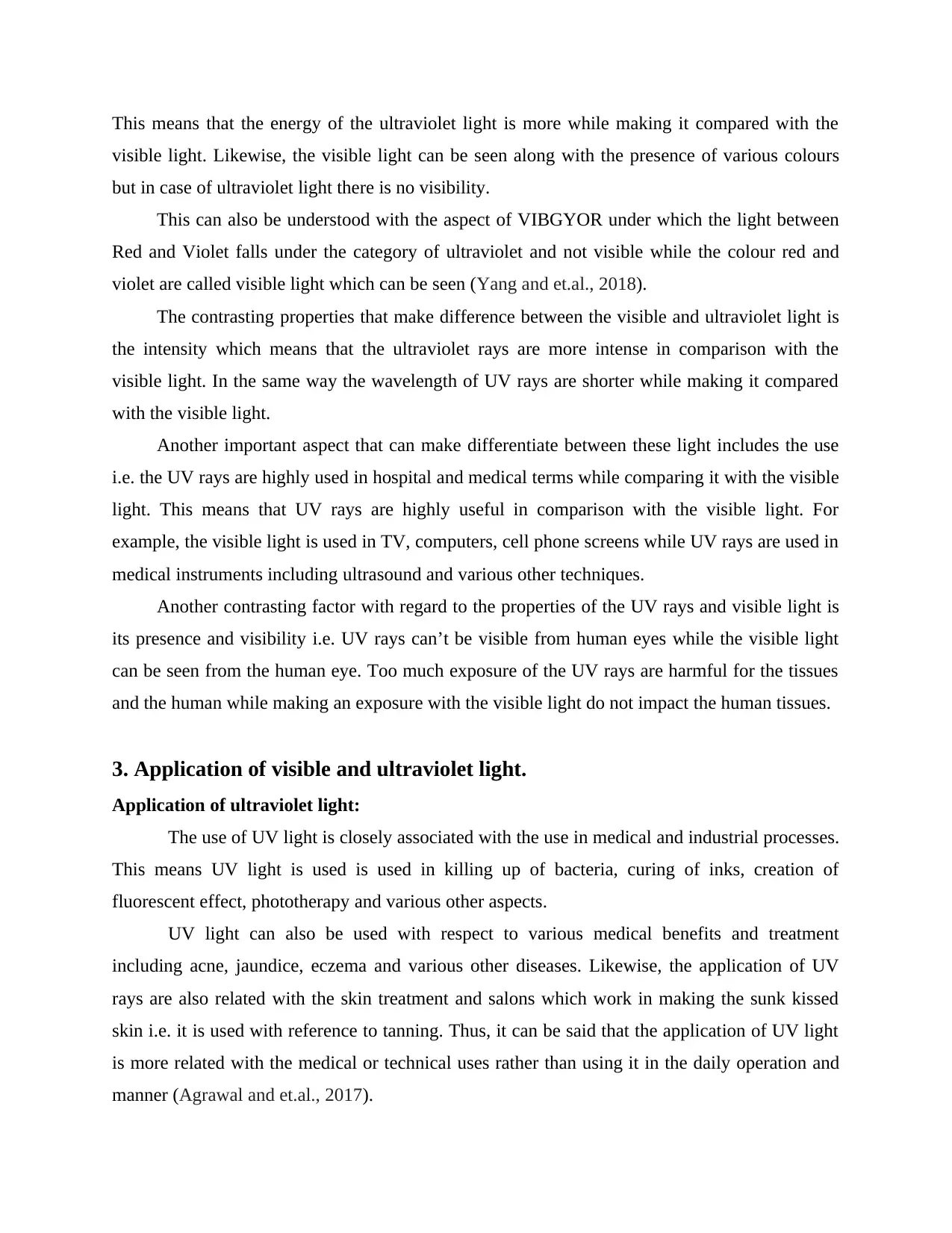
This means that the energy of the ultraviolet light is more while making it compared with the
visible light. Likewise, the visible light can be seen along with the presence of various colours
but in case of ultraviolet light there is no visibility.
This can also be understood with the aspect of VIBGYOR under which the light between
Red and Violet falls under the category of ultraviolet and not visible while the colour red and
violet are called visible light which can be seen (Yang and et.al., 2018).
The contrasting properties that make difference between the visible and ultraviolet light is
the intensity which means that the ultraviolet rays are more intense in comparison with the
visible light. In the same way the wavelength of UV rays are shorter while making it compared
with the visible light.
Another important aspect that can make differentiate between these light includes the use
i.e. the UV rays are highly used in hospital and medical terms while comparing it with the visible
light. This means that UV rays are highly useful in comparison with the visible light. For
example, the visible light is used in TV, computers, cell phone screens while UV rays are used in
medical instruments including ultrasound and various other techniques.
Another contrasting factor with regard to the properties of the UV rays and visible light is
its presence and visibility i.e. UV rays can’t be visible from human eyes while the visible light
can be seen from the human eye. Too much exposure of the UV rays are harmful for the tissues
and the human while making an exposure with the visible light do not impact the human tissues.
3. Application of visible and ultraviolet light.
Application of ultraviolet light:
The use of UV light is closely associated with the use in medical and industrial processes.
This means UV light is used is used in killing up of bacteria, curing of inks, creation of
fluorescent effect, phototherapy and various other aspects.
UV light can also be used with respect to various medical benefits and treatment
including acne, jaundice, eczema and various other diseases. Likewise, the application of UV
rays are also related with the skin treatment and salons which work in making the sunk kissed
skin i.e. it is used with reference to tanning. Thus, it can be said that the application of UV light
is more related with the medical or technical uses rather than using it in the daily operation and
manner (Agrawal and et.al., 2017).
visible light. Likewise, the visible light can be seen along with the presence of various colours
but in case of ultraviolet light there is no visibility.
This can also be understood with the aspect of VIBGYOR under which the light between
Red and Violet falls under the category of ultraviolet and not visible while the colour red and
violet are called visible light which can be seen (Yang and et.al., 2018).
The contrasting properties that make difference between the visible and ultraviolet light is
the intensity which means that the ultraviolet rays are more intense in comparison with the
visible light. In the same way the wavelength of UV rays are shorter while making it compared
with the visible light.
Another important aspect that can make differentiate between these light includes the use
i.e. the UV rays are highly used in hospital and medical terms while comparing it with the visible
light. This means that UV rays are highly useful in comparison with the visible light. For
example, the visible light is used in TV, computers, cell phone screens while UV rays are used in
medical instruments including ultrasound and various other techniques.
Another contrasting factor with regard to the properties of the UV rays and visible light is
its presence and visibility i.e. UV rays can’t be visible from human eyes while the visible light
can be seen from the human eye. Too much exposure of the UV rays are harmful for the tissues
and the human while making an exposure with the visible light do not impact the human tissues.
3. Application of visible and ultraviolet light.
Application of ultraviolet light:
The use of UV light is closely associated with the use in medical and industrial processes.
This means UV light is used is used in killing up of bacteria, curing of inks, creation of
fluorescent effect, phototherapy and various other aspects.
UV light can also be used with respect to various medical benefits and treatment
including acne, jaundice, eczema and various other diseases. Likewise, the application of UV
rays are also related with the skin treatment and salons which work in making the sunk kissed
skin i.e. it is used with reference to tanning. Thus, it can be said that the application of UV light
is more related with the medical or technical uses rather than using it in the daily operation and
manner (Agrawal and et.al., 2017).
Paraphrase This Document
Need a fresh take? Get an instant paraphrase of this document with our AI Paraphraser
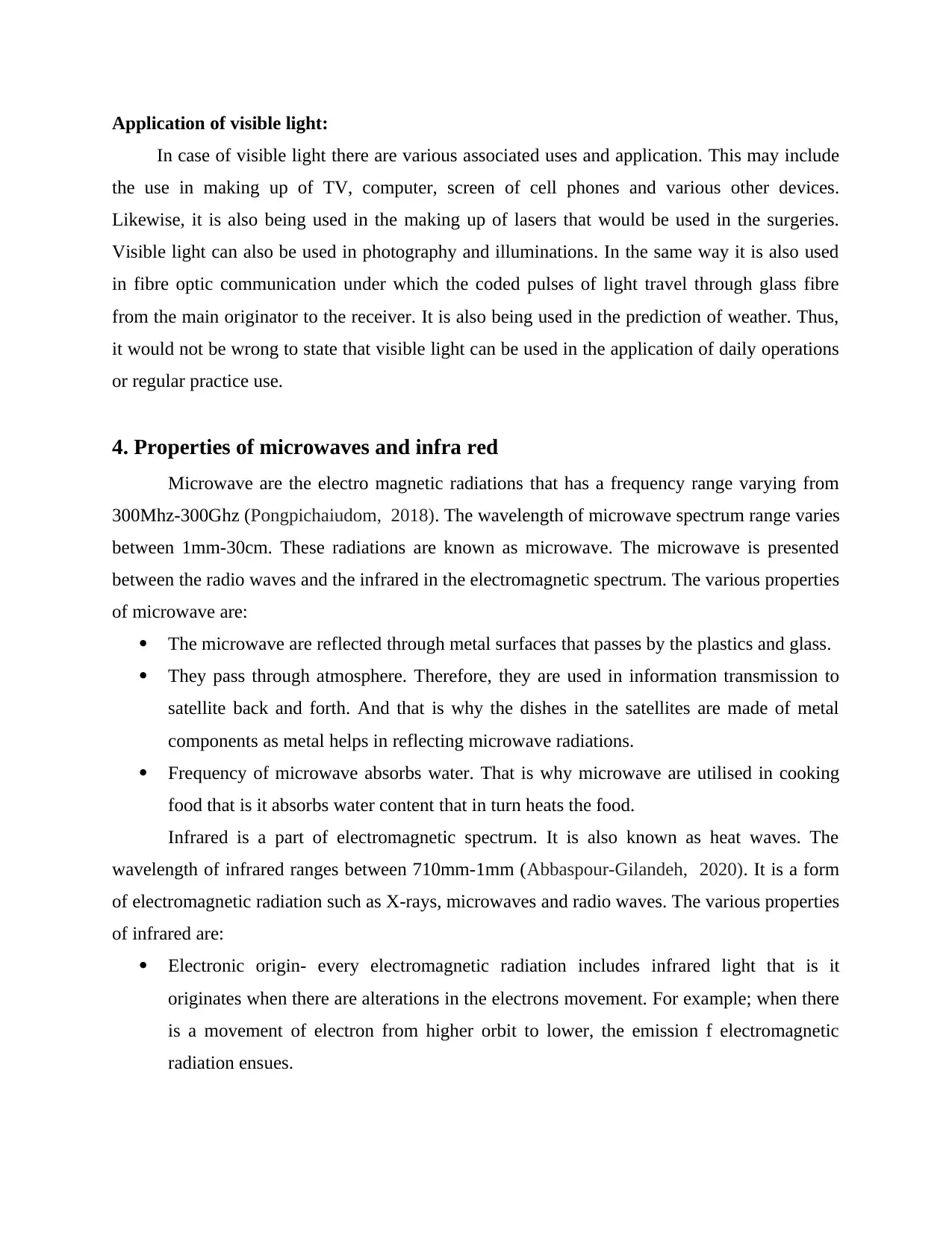
Application of visible light:
In case of visible light there are various associated uses and application. This may include
the use in making up of TV, computer, screen of cell phones and various other devices.
Likewise, it is also being used in the making up of lasers that would be used in the surgeries.
Visible light can also be used in photography and illuminations. In the same way it is also used
in fibre optic communication under which the coded pulses of light travel through glass fibre
from the main originator to the receiver. It is also being used in the prediction of weather. Thus,
it would not be wrong to state that visible light can be used in the application of daily operations
or regular practice use.
4. Properties of microwaves and infra red
Microwave are the electro magnetic radiations that has a frequency range varying from
300Mhz-300Ghz (Pongpichaiudom, 2018). The wavelength of microwave spectrum range varies
between 1mm-30cm. These radiations are known as microwave. The microwave is presented
between the radio waves and the infrared in the electromagnetic spectrum. The various properties
of microwave are:
The microwave are reflected through metal surfaces that passes by the plastics and glass.
They pass through atmosphere. Therefore, they are used in information transmission to
satellite back and forth. And that is why the dishes in the satellites are made of metal
components as metal helps in reflecting microwave radiations.
Frequency of microwave absorbs water. That is why microwave are utilised in cooking
food that is it absorbs water content that in turn heats the food.
Infrared is a part of electromagnetic spectrum. It is also known as heat waves. The
wavelength of infrared ranges between 710mm-1mm (Abbaspour-Gilandeh, 2020). It is a form
of electromagnetic radiation such as X-rays, microwaves and radio waves. The various properties
of infrared are:
Electronic origin- every electromagnetic radiation includes infrared light that is it
originates when there are alterations in the electrons movement. For example; when there
is a movement of electron from higher orbit to lower, the emission f electromagnetic
radiation ensues.
In case of visible light there are various associated uses and application. This may include
the use in making up of TV, computer, screen of cell phones and various other devices.
Likewise, it is also being used in the making up of lasers that would be used in the surgeries.
Visible light can also be used in photography and illuminations. In the same way it is also used
in fibre optic communication under which the coded pulses of light travel through glass fibre
from the main originator to the receiver. It is also being used in the prediction of weather. Thus,
it would not be wrong to state that visible light can be used in the application of daily operations
or regular practice use.
4. Properties of microwaves and infra red
Microwave are the electro magnetic radiations that has a frequency range varying from
300Mhz-300Ghz (Pongpichaiudom, 2018). The wavelength of microwave spectrum range varies
between 1mm-30cm. These radiations are known as microwave. The microwave is presented
between the radio waves and the infrared in the electromagnetic spectrum. The various properties
of microwave are:
The microwave are reflected through metal surfaces that passes by the plastics and glass.
They pass through atmosphere. Therefore, they are used in information transmission to
satellite back and forth. And that is why the dishes in the satellites are made of metal
components as metal helps in reflecting microwave radiations.
Frequency of microwave absorbs water. That is why microwave are utilised in cooking
food that is it absorbs water content that in turn heats the food.
Infrared is a part of electromagnetic spectrum. It is also known as heat waves. The
wavelength of infrared ranges between 710mm-1mm (Abbaspour-Gilandeh, 2020). It is a form
of electromagnetic radiation such as X-rays, microwaves and radio waves. The various properties
of infrared are:
Electronic origin- every electromagnetic radiation includes infrared light that is it
originates when there are alterations in the electrons movement. For example; when there
is a movement of electron from higher orbit to lower, the emission f electromagnetic
radiation ensues.
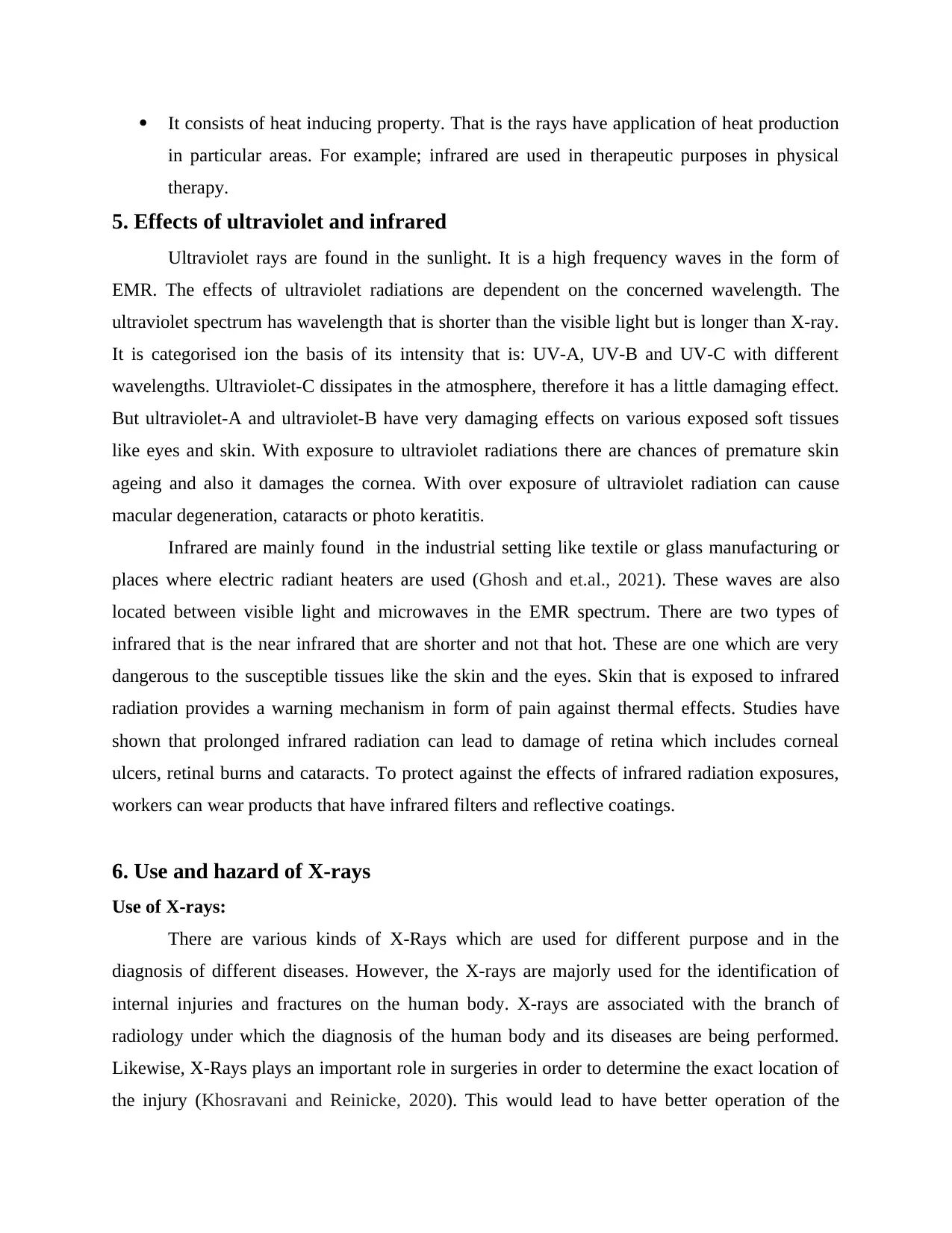
It consists of heat inducing property. That is the rays have application of heat production
in particular areas. For example; infrared are used in therapeutic purposes in physical
therapy.
5. Effects of ultraviolet and infrared
Ultraviolet rays are found in the sunlight. It is a high frequency waves in the form of
EMR. The effects of ultraviolet radiations are dependent on the concerned wavelength. The
ultraviolet spectrum has wavelength that is shorter than the visible light but is longer than X-ray.
It is categorised ion the basis of its intensity that is: UV-A, UV-B and UV-C with different
wavelengths. Ultraviolet-C dissipates in the atmosphere, therefore it has a little damaging effect.
But ultraviolet-A and ultraviolet-B have very damaging effects on various exposed soft tissues
like eyes and skin. With exposure to ultraviolet radiations there are chances of premature skin
ageing and also it damages the cornea. With over exposure of ultraviolet radiation can cause
macular degeneration, cataracts or photo keratitis.
Infrared are mainly found in the industrial setting like textile or glass manufacturing or
places where electric radiant heaters are used (Ghosh and et.al., 2021). These waves are also
located between visible light and microwaves in the EMR spectrum. There are two types of
infrared that is the near infrared that are shorter and not that hot. These are one which are very
dangerous to the susceptible tissues like the skin and the eyes. Skin that is exposed to infrared
radiation provides a warning mechanism in form of pain against thermal effects. Studies have
shown that prolonged infrared radiation can lead to damage of retina which includes corneal
ulcers, retinal burns and cataracts. To protect against the effects of infrared radiation exposures,
workers can wear products that have infrared filters and reflective coatings.
6. Use and hazard of X-rays
Use of X-rays:
There are various kinds of X-Rays which are used for different purpose and in the
diagnosis of different diseases. However, the X-rays are majorly used for the identification of
internal injuries and fractures on the human body. X-rays are associated with the branch of
radiology under which the diagnosis of the human body and its diseases are being performed.
Likewise, X-Rays plays an important role in surgeries in order to determine the exact location of
the injury (Khosravani and Reinicke, 2020). This would lead to have better operation of the
in particular areas. For example; infrared are used in therapeutic purposes in physical
therapy.
5. Effects of ultraviolet and infrared
Ultraviolet rays are found in the sunlight. It is a high frequency waves in the form of
EMR. The effects of ultraviolet radiations are dependent on the concerned wavelength. The
ultraviolet spectrum has wavelength that is shorter than the visible light but is longer than X-ray.
It is categorised ion the basis of its intensity that is: UV-A, UV-B and UV-C with different
wavelengths. Ultraviolet-C dissipates in the atmosphere, therefore it has a little damaging effect.
But ultraviolet-A and ultraviolet-B have very damaging effects on various exposed soft tissues
like eyes and skin. With exposure to ultraviolet radiations there are chances of premature skin
ageing and also it damages the cornea. With over exposure of ultraviolet radiation can cause
macular degeneration, cataracts or photo keratitis.
Infrared are mainly found in the industrial setting like textile or glass manufacturing or
places where electric radiant heaters are used (Ghosh and et.al., 2021). These waves are also
located between visible light and microwaves in the EMR spectrum. There are two types of
infrared that is the near infrared that are shorter and not that hot. These are one which are very
dangerous to the susceptible tissues like the skin and the eyes. Skin that is exposed to infrared
radiation provides a warning mechanism in form of pain against thermal effects. Studies have
shown that prolonged infrared radiation can lead to damage of retina which includes corneal
ulcers, retinal burns and cataracts. To protect against the effects of infrared radiation exposures,
workers can wear products that have infrared filters and reflective coatings.
6. Use and hazard of X-rays
Use of X-rays:
There are various kinds of X-Rays which are used for different purpose and in the
diagnosis of different diseases. However, the X-rays are majorly used for the identification of
internal injuries and fractures on the human body. X-rays are associated with the branch of
radiology under which the diagnosis of the human body and its diseases are being performed.
Likewise, X-Rays plays an important role in surgeries in order to determine the exact location of
the injury (Khosravani and Reinicke, 2020). This would lead to have better operation of the
⊘ This is a preview!⊘
Do you want full access?
Subscribe today to unlock all pages.

Trusted by 1+ million students worldwide
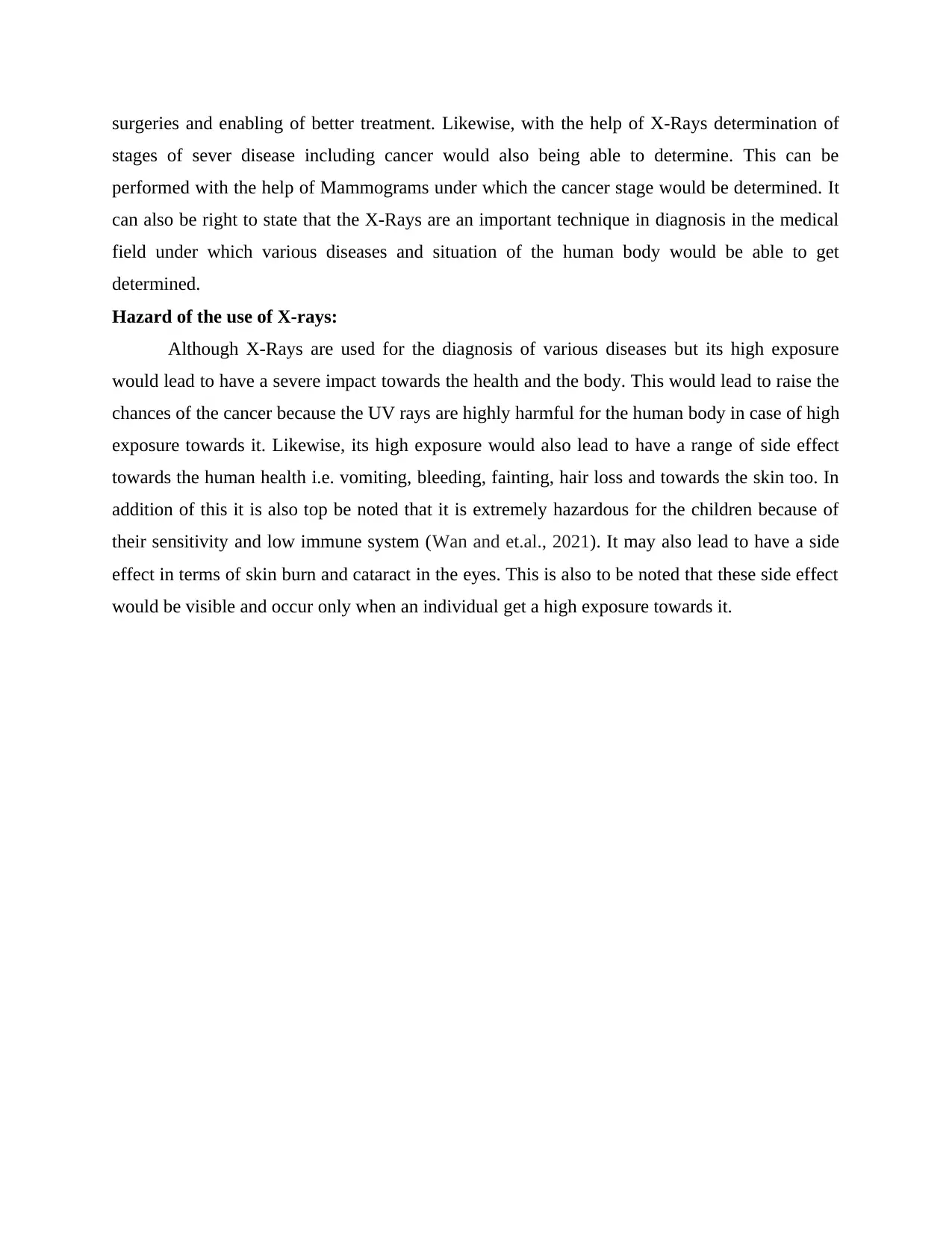
surgeries and enabling of better treatment. Likewise, with the help of X-Rays determination of
stages of sever disease including cancer would also being able to determine. This can be
performed with the help of Mammograms under which the cancer stage would be determined. It
can also be right to state that the X-Rays are an important technique in diagnosis in the medical
field under which various diseases and situation of the human body would be able to get
determined.
Hazard of the use of X-rays:
Although X-Rays are used for the diagnosis of various diseases but its high exposure
would lead to have a severe impact towards the health and the body. This would lead to raise the
chances of the cancer because the UV rays are highly harmful for the human body in case of high
exposure towards it. Likewise, its high exposure would also lead to have a range of side effect
towards the human health i.e. vomiting, bleeding, fainting, hair loss and towards the skin too. In
addition of this it is also top be noted that it is extremely hazardous for the children because of
their sensitivity and low immune system (Wan and et.al., 2021). It may also lead to have a side
effect in terms of skin burn and cataract in the eyes. This is also to be noted that these side effect
would be visible and occur only when an individual get a high exposure towards it.
stages of sever disease including cancer would also being able to determine. This can be
performed with the help of Mammograms under which the cancer stage would be determined. It
can also be right to state that the X-Rays are an important technique in diagnosis in the medical
field under which various diseases and situation of the human body would be able to get
determined.
Hazard of the use of X-rays:
Although X-Rays are used for the diagnosis of various diseases but its high exposure
would lead to have a severe impact towards the health and the body. This would lead to raise the
chances of the cancer because the UV rays are highly harmful for the human body in case of high
exposure towards it. Likewise, its high exposure would also lead to have a range of side effect
towards the human health i.e. vomiting, bleeding, fainting, hair loss and towards the skin too. In
addition of this it is also top be noted that it is extremely hazardous for the children because of
their sensitivity and low immune system (Wan and et.al., 2021). It may also lead to have a side
effect in terms of skin burn and cataract in the eyes. This is also to be noted that these side effect
would be visible and occur only when an individual get a high exposure towards it.
Paraphrase This Document
Need a fresh take? Get an instant paraphrase of this document with our AI Paraphraser
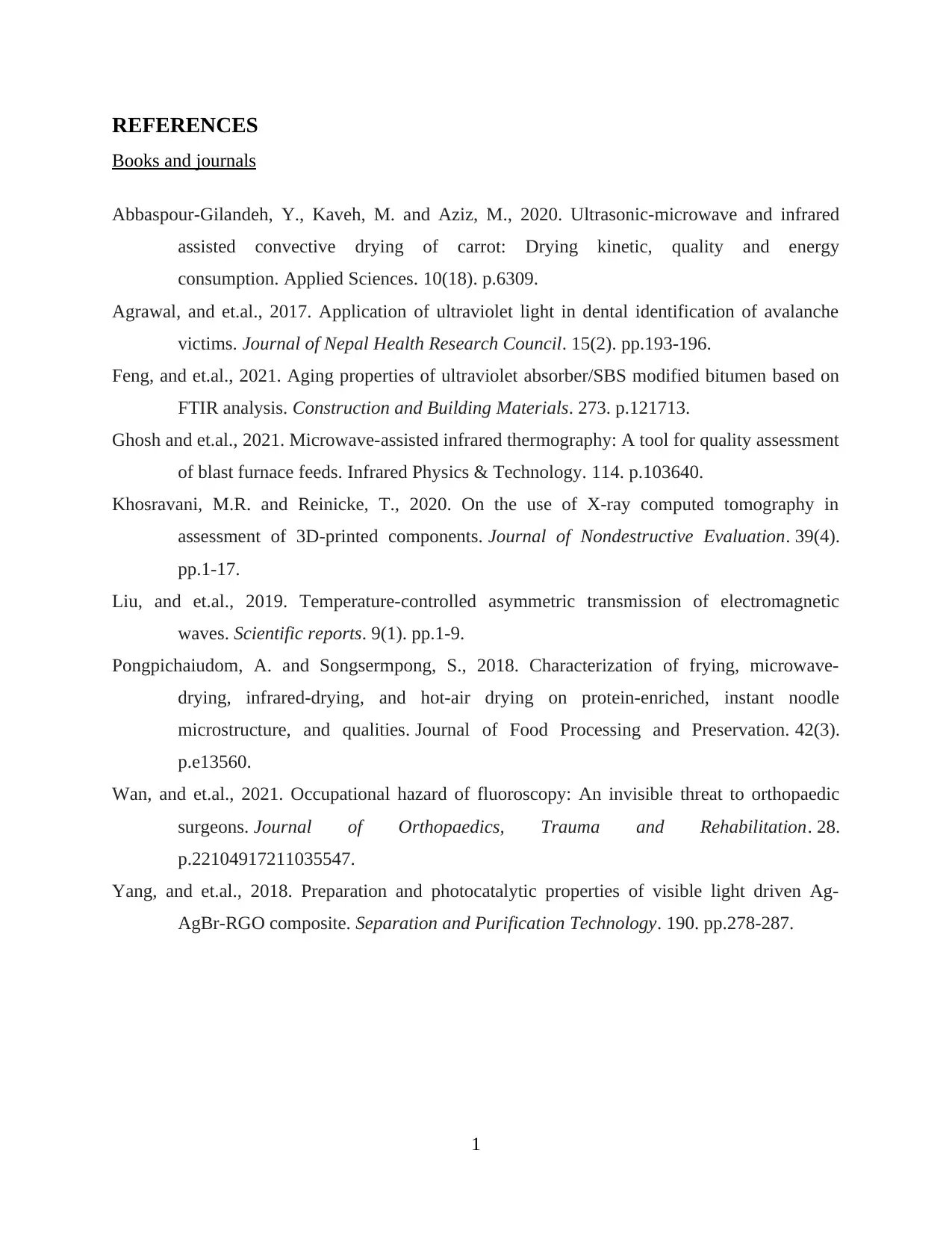
REFERENCES
Books and journals
Abbaspour-Gilandeh, Y., Kaveh, M. and Aziz, M., 2020. Ultrasonic-microwave and infrared
assisted convective drying of carrot: Drying kinetic, quality and energy
consumption. Applied Sciences. 10(18). p.6309.
Agrawal, and et.al., 2017. Application of ultraviolet light in dental identification of avalanche
victims. Journal of Nepal Health Research Council. 15(2). pp.193-196.
Feng, and et.al., 2021. Aging properties of ultraviolet absorber/SBS modified bitumen based on
FTIR analysis. Construction and Building Materials. 273. p.121713.
Ghosh and et.al., 2021. Microwave-assisted infrared thermography: A tool for quality assessment
of blast furnace feeds. Infrared Physics & Technology. 114. p.103640.
Khosravani, M.R. and Reinicke, T., 2020. On the use of X-ray computed tomography in
assessment of 3D-printed components. Journal of Nondestructive Evaluation. 39(4).
pp.1-17.
Liu, and et.al., 2019. Temperature-controlled asymmetric transmission of electromagnetic
waves. Scientific reports. 9(1). pp.1-9.
Pongpichaiudom, A. and Songsermpong, S., 2018. Characterization of frying, microwave‐
drying, infrared‐drying, and hot‐air drying on protein‐enriched, instant noodle
microstructure, and qualities. Journal of Food Processing and Preservation. 42(3).
p.e13560.
Wan, and et.al., 2021. Occupational hazard of fluoroscopy: An invisible threat to orthopaedic
surgeons. Journal of Orthopaedics, Trauma and Rehabilitation. 28.
p.22104917211035547.
Yang, and et.al., 2018. Preparation and photocatalytic properties of visible light driven Ag-
AgBr-RGO composite. Separation and Purification Technology. 190. pp.278-287.
1
Books and journals
Abbaspour-Gilandeh, Y., Kaveh, M. and Aziz, M., 2020. Ultrasonic-microwave and infrared
assisted convective drying of carrot: Drying kinetic, quality and energy
consumption. Applied Sciences. 10(18). p.6309.
Agrawal, and et.al., 2017. Application of ultraviolet light in dental identification of avalanche
victims. Journal of Nepal Health Research Council. 15(2). pp.193-196.
Feng, and et.al., 2021. Aging properties of ultraviolet absorber/SBS modified bitumen based on
FTIR analysis. Construction and Building Materials. 273. p.121713.
Ghosh and et.al., 2021. Microwave-assisted infrared thermography: A tool for quality assessment
of blast furnace feeds. Infrared Physics & Technology. 114. p.103640.
Khosravani, M.R. and Reinicke, T., 2020. On the use of X-ray computed tomography in
assessment of 3D-printed components. Journal of Nondestructive Evaluation. 39(4).
pp.1-17.
Liu, and et.al., 2019. Temperature-controlled asymmetric transmission of electromagnetic
waves. Scientific reports. 9(1). pp.1-9.
Pongpichaiudom, A. and Songsermpong, S., 2018. Characterization of frying, microwave‐
drying, infrared‐drying, and hot‐air drying on protein‐enriched, instant noodle
microstructure, and qualities. Journal of Food Processing and Preservation. 42(3).
p.e13560.
Wan, and et.al., 2021. Occupational hazard of fluoroscopy: An invisible threat to orthopaedic
surgeons. Journal of Orthopaedics, Trauma and Rehabilitation. 28.
p.22104917211035547.
Yang, and et.al., 2018. Preparation and photocatalytic properties of visible light driven Ag-
AgBr-RGO composite. Separation and Purification Technology. 190. pp.278-287.
1

2
⊘ This is a preview!⊘
Do you want full access?
Subscribe today to unlock all pages.

Trusted by 1+ million students worldwide
1 out of 9
Your All-in-One AI-Powered Toolkit for Academic Success.
+13062052269
info@desklib.com
Available 24*7 on WhatsApp / Email
![[object Object]](/_next/static/media/star-bottom.7253800d.svg)
Unlock your academic potential
Copyright © 2020–2025 A2Z Services. All Rights Reserved. Developed and managed by ZUCOL.


